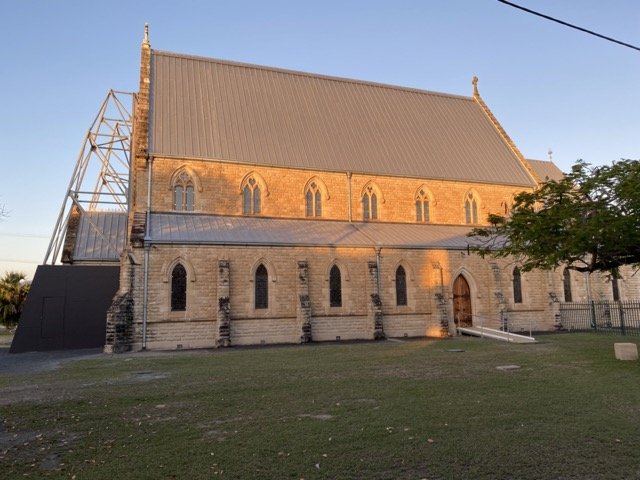History & Learning
The foundation stone for St Paul's Church was laid on 16 September 1879, with the building completed in 1883 to replace a wooden structure which had been built in 1862, after the previous hardwood slab building had been destroyed by a severe tropical storm on 26 November 1860. St Paul's Church, constructed of local area sandstone, was consecrated on 18 October 1883, with 30 free pews and 156 rented pews. With the formation of the Diocese of Rockhampton in 1892 the church became a Cathedral as the seat of the first Bishop Nathaniel Dawes.
Plans and specifications for the building were originally prepared by Brisbane architect Annersley Voysey and later revised by AW Voysey and Frank Scarer, with construction undertaken by stonemasons Paul and George Sanderson, carpentry by David Wiley, plumbing by J Wakefield, and painting by W Aspinall. Entrance gates, designed by Louis Spier Robertson, were added in 1899.
In 1917 the Cathedral became the first public building in Rockhampton to be lit with electricity. Over the years other changes have been made to the interior of the building with a tabernacle installed in the 1920s along with a rood screen dedicated in 1925 as a memorial to those who died in the First World War. In 1968 when the High Altar was moved from the eastern wall of the chancel to a more central position on the sanctuary the rood screen was removed, and the crucifix which was part of this screen affixed to a wall near the lectern. A Warriors Chapel was added to the eastern end of the one of the aisles in 1916, and a Lady's Chapel was created in the other aisle in the 1950s.
The original organ built by J Porritt managed to be salvaged when the ship transporting it from England was wrecked off Cape Capricorn in July 1883. It and the original choir stalls were housed in the chancel until 1966 when the present instrument built in Middlesex, England arrived, and both were relocated to the west end of the building.
The building contains a number of high quality stained and coloured glass windows, including the Christus Window, depicting the Lord as ‘the Way, the Truth and the Life’, given by the Officers and workmen of the Railway Department to commemorate the lives of their fellows who died in the 1914-18 War. Many of the windows are the works of William Bustard. A set of windows depicting the history of the Christian Church are located in the sanctuary, and a Coronation Window commemorates her Majesty Queen Elizabeth’s visit to the city in 1954.
A bell tower with a peal of eight bells was erected in 1947 as a thanksgiving for peace and a memorial to those killed in in World War II. The bells were cast by Gillet and Johnson in Croydon England, and the tower designed by well-known local architect Eddie Hegvold.
The Cathedral suffered damage as a result of Cyclone Marcia in February 2015, with the roof being fully replaced. However, movement in the front wall saw the building closed in March 2017 due to safety concerns. Engineering design was subsequently completed, with stabilisation works commence in September 2019 to allow for the Cathedral’s reopening at the beginning of 2020.
St Paul’s Cathedral is a very important Rockhampton landmark, a lasting symbol of the history and growth of the area and has made a unique contribution to the church and community. It has been part of the life of many generations with weddings, baptisms, funerals and other family occasions. It has also fulfilled a civic role with special community worship services, arts and cultural events that make use of its wonderful acoustics. In times of conflict and war it has been a place of refuge and support, serving as the Garrison Chapel for the 42nd Battalion and being recognised for the connection which began with US troops stationed in the area in World War 11.
It is a place of tranquillity in the heart of a growing and energetic city.












